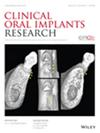Long-Term Outcomes of Single-Implant Mandibular Overdentures: A 8-10 Year Prospective Study Across Two Cohorts.
IF 5.3
1区 医学
Q1 DENTISTRY, ORAL SURGERY & MEDICINE
引用次数: 0
Abstract
OBJECTIVES This study aimed to evaluate the long-term outcomes of two prospective cohorts of edentulous individuals treated with single implant mandibular overdentures (SIMO) opposed by a conventional maxillary complete denture. MATERIAL AND METHODS A total of 74 participants, treated between 2013 and 2016 at the School of Dentistry of the Federal University of Goiás, Brazil, were included. A single midline implant was placed in the edentulous mandible; 93.2% of implants were immediately loaded, and outcomes were followed for 8-10 years. Data collected included dental patient-reported outcomes (dPROs), implant survival, implant stability, peri-implant health, and incidence of prosthodontic events. The frequency of the prosthetic maintenance and complication events was reported in terms of cumulative incidence. Within-group longitudinal changes were tested using paired comparison tests. A significance level of p < 0.05 was used for statistical inferences. RESULTS Significant improvements in OHIP-Edent and satisfaction scores were observed immediately post-treatment and maintained throughout the follow-up period, confirming a significant positive effect of SIMO on these outcomes (p < 0.001). The overall implant survival rate was 95.6%. Peri-implant outcomes showed favorable health status, with mild bone loss observed (-1.55 ± 1.09 mm at the 8-10-year follow-up). Prosthetic complications and the need for recall visits for maintenance were common. The most frequent prosthetic complications were matrix replacement (43.3%) and overdenture fracture (12.4%). CONCLUSIONS SIMO demonstrated sustained long-term effectiveness with regular clinical monitoring and frequent maintenance. For most patients, the positive initial outcomes continued for up to 10 years, suggesting SIMO particularly benefits older patients with financial constraints.单种植下颌覆盖义齿的长期疗效:一项跨两个队列的8-10年前瞻性研究。
目的:本研究旨在评估两组前瞻性无牙患者使用单种植下颌覆盖义齿(SIMO)与传统上颌全口义齿治疗的长期结果。材料与方法纳入2013年至2016年在巴西联邦大学Goiás牙科学院接受治疗的74名参与者。在无牙下颌骨放置单根中线种植体;93.2%的植入物立即加载,随访8-10年。收集的数据包括牙科患者报告的结果(dPROs)、种植体存活、种植体稳定性、种植体周围健康和修复事件的发生率。假体维护和并发症事件的频率以累积发生率报道。组内纵向变化采用配对比较检验。采用p < 0.05的显著性水平进行统计学推断。结果治疗后立即观察到ohip - eent和满意度得分的显著改善,并在整个随访期间保持,证实了SIMO对这些结果的显着积极作用(p < 0.001)。种植体整体成活率为95.6%。种植体周围结果显示良好的健康状况,观察到轻度骨质流失(8-10年随访-1.55±1.09 mm)。假体并发症和需要召回维修是常见的。最常见的假体并发症是基质置换(43.3%)和覆盖义齿骨折(12.4%)。结论ssimo在定期临床监测和频繁维护下具有持续的长期疗效。对于大多数患者,积极的初步结果持续长达10年,这表明SIMO特别有利于经济拮据的老年患者。
本文章由计算机程序翻译,如有差异,请以英文原文为准。
求助全文
约1分钟内获得全文
求助全文
来源期刊

Clinical Oral Implants Research
医学-工程:生物医学
CiteScore
7.70
自引率
11.60%
发文量
149
审稿时长
3 months
期刊介绍:
Clinical Oral Implants Research conveys scientific progress in the field of implant dentistry and its related areas to clinicians, teachers and researchers concerned with the application of this information for the benefit of patients in need of oral implants. The journal addresses itself to clinicians, general practitioners, periodontists, oral and maxillofacial surgeons and prosthodontists, as well as to teachers, academicians and scholars involved in the education of professionals and in the scientific promotion of the field of implant dentistry.
 求助内容:
求助内容: 应助结果提醒方式:
应助结果提醒方式:


